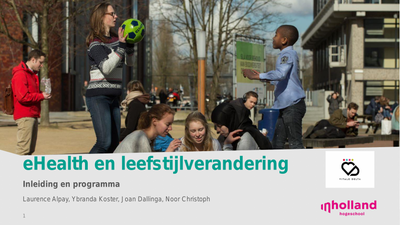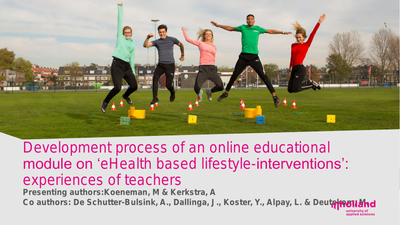eHealth education should be integrated into vocational training and continuous professional development programmes. In this opinion article, we aim to support organisers of Continuing Professional Development (CPD) and teachers delivering medical vocational training by providing recommendations for eHealth education. First, we describe what is required to help primary care professionals and trainees learn about eHealth. Second, we elaborate on how eHealth education might be provided
DOCUMENT

Het vakgebied van de persuasieve technologie richt zich op design, ontwikkeling en evaluatie van interactieve technologieën die bedoeld zijn om de houding of het gedrag van de patiënt/ cliënt te veranderen door middel van overtuiging en sociale invloed. Het is bij uitstek een interdisciplinair onderzoeksgebied waar psychologie, mens-computer interactie en vakgebieden uit zorg en welzijn samen opereren. Het doel van de workshop was om gezamenlijk te verkennen hoe impactmeting van persuasieve technologie uitgevoerd kan worden.
DOCUMENT

Kennis maken met het begrip van persuasieve eHealth ter ondersteuning van gedragsverandering
DOCUMENT

Development process of an online educational module on ‘eHealth based lifestyle-interventions’: experiences of teachers
DOCUMENT

Abstract: This case study examines the use of an eHealth application for improving preoperative rehabilitation (prehabilitation). We have analysed healthcare professionals' motivators and drivers for adopting eHealth for a surgical procedure at academic medical facilities. The research focused on when and why healthcare professionals are inclined to adopt eHealth applications in their way of working? For this qualitative study, we selected 12 professionals involved in all levels of the organisation and stages of the medical process and conducted semi-structured interviews. Kotter’s transformational change model and the Technology Acceptance Model were used as analytical frameworks for the identification of the motivation of eHealth adoption. The findings suggest that contrary to Kotter’s change model, which argues that adoption of change is based on perceptions and feelings, the healthcare drivers are rational when it comes to deciding whether or not to adopt eHealth apps. This study further elaborates the observation made by the Dutch expertise centre on eHealth, Nictiz, that when the value of an eHealth pplication is clear for a stakeholder, the adoption process accelerates. Analysis of the motivations and drivers of the healthcare professionals show a strong relationship with an evidence-based grounding of usefulness and the responsibility these professionals have towards their patients. We found that healthcare professionals respond to the primary goal of improving healthcare. This is true if the eHealth application will innovate their work, but mainly when the application will improve the patient care they are responsible for. When eHealth applications are implemented, rational facts need to be collected in a study before deployment of eHealth applications on how these applications will improve the patient's health or wellbeing throughout their so-called medical journey for their treatment. Furthermore, the preference to learn about new eHealth applications from someone who speaks from authority through expertise on the subject matter, suggests adoption by healthcare professionals may be accelerated through peers. The result of this study may provide healthcare management with a different approach to their eHealth strategy. Future research is needed to validate the findings in different medical organisational settings such as regional healthcare facilities or for-profit centers which do not necessarily have an innovation focus but are driven by other strategic drivers.
DOCUMENT

Integrated approach aims at bridging the gap between theory and practice in designing persuasive eHealth applications. Developed from a didactic and educational perspective and is being implemented in our master program. It enables our master students to design user-centered persuasive eHealth applications. Inspiring educators on how to teach design of persuasive eHealth applications and support development of best practices in this area.
DOCUMENT

eHealth to support outpatient geriatric rehabilitation is promising for blended care interventions. Further work will be carried out to establish the requirements to embed the applications from the ikoefenzelf.nl platform into the home-based setting.
DOCUMENT

Samenvatting Achtergrond: Een integrale behandeling inclusief zelfmanagement bij chronisch obstructieve longziekte (COPD) leidt tot betere klinische resultaten. eHealth kan zorgen voor meer betrokkenheid bij patiënten waardoor ze in staat zijn een gezondere levensstijl aan te nemen en vast te houden. Desondanks is er geen eenduidig bewijs van de impact van eHealth op de kwaliteit van leven (quality of life (QoL)). Doel: Het primaire doel van de e-Vita COPD-studie was om te onderzoeken wat de effecten zijn van het gebruik van eeneHealth-platform voor patiënten op de verschillende domeinen van ziektespecifieke kwaliteit van leven van COPD-patiënten (CCQ). Methoden: We hebben de impact beoordeeld van het gebruik van een eHealth-platform op de klinische COPD-vragenlijst (CCQ). Deze vragenlijst omvatte subschalen van symptomen, functionele en mentale toestand. Een design met onderbroken tijdreeksen (interrupted time series (ITS)) is gebruikt om CCQ-gegevens op verschillende tijdstippen te verzamelen. Er is gebruik gemaakt van multilevel lineaire regressieanalyse om de CCQ-trends vóór en na de interventie te vergelijken. Resultaten: Van de 742 uitgenodigde COPD-patiënten hebben er 244 het document voor ‘informed consent’ ondertekend. In de analyses hebben we uitsluitend patiënten opgenomen die daadwerkelijk gebruik hebben gemaakt van het eHealthplatform (n=123). De afname van CCQ-symptomen was 0,20% vóór de interventie en 0,27% na de interventie; dit was een statistisch significant verschil (P=0,027). De daling van CCQ-mentale toestand was 0,97% vóór de interventie en na de interventie was er sprake van een stijging van 0,017%; dit verschil was statistisch significant (P=0,01). Er werd geen significant verschil vastgesteld in het verloop van CCQ (P=0,12) en CCQ-functionele toestand (P=0,11) vóór en na de interventie. Conclusie: Het e-Vita eHealth-platform had een gunstig effect op de CCQ-symptomen van COPD-patiënten, maar niet op de functionele status. De CCQ-mentale toestand bleef stabiel na de interventie, maar dit was een verslechtering in vergelijking met de verbeterende situatie voorafgaand aan de start van het eHealth-platform. Deze studie laat dus zien dat patiënten na de introductie van het COPD-platform minder symptomen ervaarden, maar dat hun mentale toestand tegelijkertijd licht verslechterde. Zorgprofessionals moeten zich ervan bewust zijn dat, ondanks de verbetering van symptomen, er een lichte toename van angst en depressie kan optreden na invoering van een eHealth-interventie.
DOCUMENT

Alongside the growing number of older persons, the prevalence of chronic diseases is increasing, leading to higher pressure on health care services. eHealth is considered a solution for better and more efficient health care. However, not every patient is able to use eHealth, for several reasons. This study aims to provide an overview of: (1) sociodemographic factors that influence the use of eHealth; and (2) suggest directions for interventions that will improve the use of eHealth in patients with chronic disease. A structured literature review of PubMed, ScienceDirect, Association for Computing Machinery Digital Library (ACMDL), and Cumulative Index to Nursing and Allied Health Literature (CINAHL) was conducted using four sets of keywords: “chronic disease”, “eHealth”, “factors”, and “suggested interventions”. Qualitative, quantitative, and mixed-method studies were included. Four researchers each assessed quality and extracted data. Twenty-two out of 1639 articles were included. Higher age and lower income, lower education, living alone, and living in rural areas were found to be associated with lower eHealth use. Ethnicity revealed mixed outcomes. Suggested solutions were personalized support, social support, use of different types of Internet devices to deliver eHealth, and involvement of patients in the development of eHealth interventions. It is concluded that eHealth is least used by persons who need it most. Tailored delivery of eHealth is recommended
DOCUMENT

Co-creation steps of an online educational module on eHealth for lifestyle improvement.
MULTIFILE
